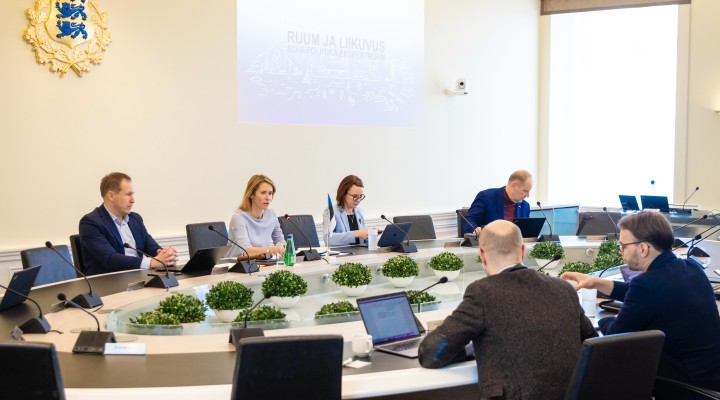“Although energy has been the main topic of discussion of late, because of the energy crisis and rising prices, green issues touch on every part of life,” said Prime Minister Kaja Kallas, who chairs the committee. “That is why we focussed on mobility, spatial planning and construction today, where there is enormous potential to adopt a more environmentally friendly approach. I am grateful to the expert group for their dedicated work. We will now set about analysing which proposals we can implement, in which order and to what sort of timeframe. Our aim is to improve the living and working environment for the people of Estonia, to make our economy stronger and more sustainable and to achieve a cleaner and better maintained environment.”
According to the expert group, the rapid spread of built-up areas is problematic in conditions of declining population numbers. It has led to investments mainly being centred around the use of personal vehicles, with far less attention being paid to the development of public transport, cycling and walking. The spontaneous encroachment of large urban settlements on country areas is placing a burden on the environment, causing growth in forced movement and resulting in inequality in the availability of public services and in spatial quality. There is also insufficient cooperation at the local government level in regard to spatial planning.
“These days, the greater the volume of vehicle traffic forecast for a large site, the more profitable it is likely to be,” explained mobility expert Marek Rannala, who set out the expert group’s proposals regarding transport. “Changing direction on that front means replacing what has been prioritised to date with more economical and sustainable solutions. Our strategies and development plans include key green transition indicators, topics and objectives, but for some reason there are problems in following what is set out in the strategies in everyday decision-making, at both the state and local government levels. Changing that tendency is largely the key to the green transition in the mobility sector, and there is no need to reinvent the wheel in order to achieve it.”
The experts stressed that the development of transport solutions forms part of a high-quality living environment and must take place hand in hand with spatial planning. “More comprehensive, data-based planning will help put the brakes on the growth in forced movement caused by urban sprawl,” said expert group member and City of Tartu architect Tõnis Arjus. “Spatial planning requirements can be used to establish stricter environmental limits and regulate the decision-making process and cooperation of local governments across their own borders.”
In order for the transport system to be convenient and economical and for it to contribute to a reduction in the emission of greenhouse gases, the experts recommend establishing a motivating regulatory mechanism to bind strategies supporting more environmentally friendly mobility to longer-term budget planning. An approach must be adopted which foresees a fully integrated public transport solution for larger regions, makes more use of a demand-based service model and takes into account not only bus transport, but also train transport and other mobility services. The state requires a plan for the creation of electric car recharging infrastructure covering the entire country so that charging is possible in apartment complexes, outside of towns and cities and in areas away from main roads. A future-proof system of transport taxation must be developed which promotes sustainable choices, is fair to both urban and rural dwellers and guarantees the revenue necessary for investing in infrastructure.
Cooperation and joint planning between local governments would enable problems with the availability of public services to be prevented, the environmental footprint produced in the course of their provision to be reduced and a better, more fit-for-purpose living environment with functioning ecosystems to be created. The availability of the financial instruments foreseen for local governments must be linked to the fulfilment of climate goals. Within spatial planning this would mean, among other things, consolidating existing settlements, adapting buildings to meet new functions and supporting sustainable forms of movement through investments. The experts are also proposing that the volume of renovations be trebled, allocating additional resources to achieve this, bringing all required documentation into line and assisting apartment associations in drawing up projects.
In order to support communities and create better synergy between the state and local governments, a raft of legal amendments and measures are being proposed on how to improve cooperation and coordination between parties and how to boost the effectiveness of impact analysis.
The remaining chapters in the expert group’s report, which will be introduced to the government in the coming weeks, are dedicated to a sustainable food system, the circular economy and waste, biodiversity, land use and the enhancement of bioresources, adapting to climate change, an equitable transition in Ida-Viru County and the prevention of socioeconomic risks throughout Estonia. The full text of the report will be published on the government website.
During its previous session the green policy steering committee presented its energy recommendations: https://www.valitsus.ee/uudised/rohepoliitika-eksperdid-julgeolekukriisis-meie-kohustus-kiirendada-rohepooret
Members of expert group: https://www.valitsus.ee/uudised/tana-sai-kinnitatud-rohepoliitika-eksperdiruhma-koosseis
Gallery: https://flic.kr/s/aHBqjzHBu8
